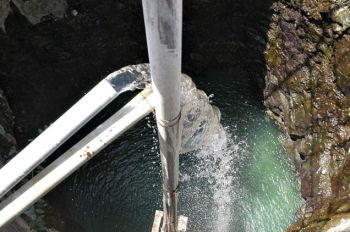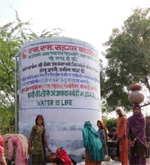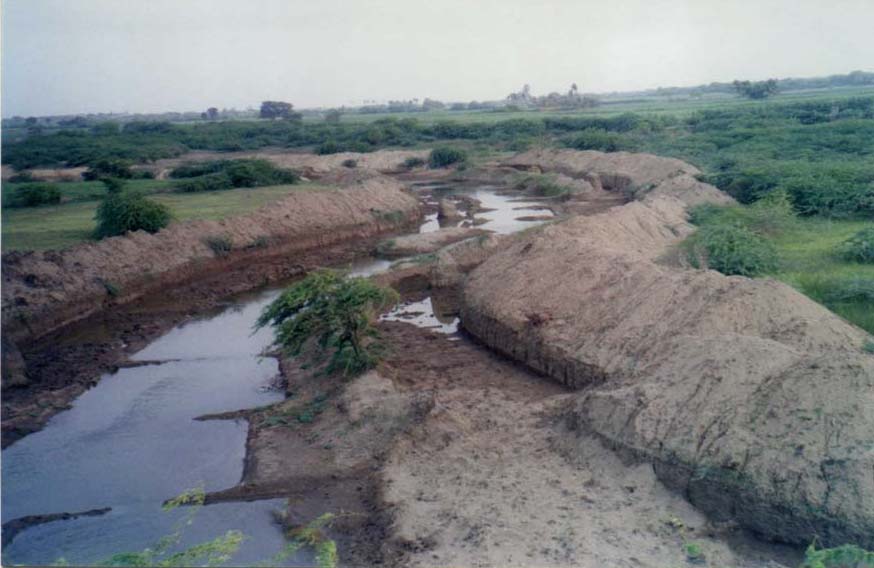Conservation - Reducing Water Usage
Managing shallow aquifers in a city
Posted on 16 Jun, 2011 06:04 PM Good option: The city needs multiple sourcing of water and open wells have the potential to provide up to a third of the requirement
Good option: The city needs multiple sourcing of water and open wells have the potential to provide up to a third of the requirement
Just how a city can be arbitrary with its policy on water management and therefore leading to sub-optimal conditions is made clear by a recent example one came across. Balasubramanian had an old open well dug to a depth of 30 ft. when he first built his house in the early 80s. The well had yielded water for quite some years but then subsequently had gone dry.
Patkhori's water solutions - A case study from the work of SM Sehgal Foundation in Mewat, Haryana
Posted on 14 Jun, 2011 05:27 PM Community water tank
Community water tank
India will have water crises by 2030 - Droplets, e-Newsletter of Everything About Water for May 2011
Posted on 31 May, 2011 12:35 PM
- India will have water crises by 2030
According to International Water Management Institute (IWMI), India will face a water scarcity due to global warming and population explosion.
Interlinking of water harvesting structures through link water channels - A viable alternative at micro-level by Ambuja Cement Foundation
Posted on 25 May, 2011 07:39 PM The coastal areas of Gujarat especially the villages lying within 20-25 km from the seashore are suffering from the problem of salinity ingress. Most of the rivulets that drain this region like Goma and Somat are seasonal at best and their water does not last beyond monsoons. The other aquifers like ponds, which get water from these rivers, also dry up as early as October.
The coastal areas of Gujarat especially the villages lying within 20-25 km from the seashore are suffering from the problem of salinity ingress. Most of the rivulets that drain this region like Goma and Somat are seasonal at best and their water does not last beyond monsoons. The other aquifers like ponds, which get water from these rivers, also dry up as early as October.
Inclusion of a component relating to rural drinking water in the special package for drought mitigation strategies in Bundelkhand region of Uttar Pradesh and Madhya Pradesh - PIB release
Posted on 22 May, 2011 05:09 PMThis would be in addition to the other measures approved by the Cabinet on 19th November, 2009 under the special package for implementing drought mitigation strategies in Bundelkhand.
Water scarcity in adivasi villages in Dungarpur, Rajasthan - Audio updates from CGNet Swara
Posted on 19 May, 2011 11:18 AMNow it is water all the way in Garhkundar–Dabar watershed of drought-prone semi-arid Bundelkhand – A paper in Current Science
Posted on 19 May, 2011 08:07 AMThe area suffers from water scarcity, natural resource degradation, low crop productivity (1–1.5 t/ha), low rainwater use efficiency (35–45 per cent), high erosion, poor soil fertility, frequent droughts, poor irrigation facilities, heavy biotic pressure on forests, inadequate vegetation cover and frequent crop failure resulting in scarcity of food, fodder and fuel. The region has serious limitations of ground and surface-water availability and heavily depends upon perched water for drinking as well as irrigation.
Case studies on rainwater harvesting and artificial recharge – A compilation by Central Ground Water Board
Posted on 17 May, 2011 09:13 PM Groundwater caters to the demand of ever growing domestic, agricultural and industrial sector of the country and is being indiscriminately exploited by several users. On the other hand, rapid urbanization and land use changes has resulted in reduced natural infiltration or recharge of aquifers.
Groundwater caters to the demand of ever growing domestic, agricultural and industrial sector of the country and is being indiscriminately exploited by several users. On the other hand, rapid urbanization and land use changes has resulted in reduced natural infiltration or recharge of aquifers.
This has led to various problems related to quantity and quality and issues like the decline in water levels, depletion of groundwater resource and quality deterioration. There is thus an imperative need for augmenting the valuable groundwater resource. Artificial recharge and roof top rainwater harvesting is one such method that can revive this precious resource. Several traditional and scientifically proven artificial recharge and rainwater harvesting techniques have been adopted in different parts of the country. These structures have proven to be viable option for augmenting the groundwater aquifers by making use of surplus surface runoff.
Peri-urban water security in a context of urbanization and climate change - A review of concepts and relationships by SaciWaters
Posted on 17 May, 2011 04:05 PM
It is a part of the peri-urban water security project discussion paper series that aims at having a collection of research papers relevant to the concepts and processes involved in the project that represent preliminary ideas circulated to encourage discussion and comments.
Though the relevant literature is cited at many places, this is not intended to be a literature review per se, but instead seeks to develop a shared framework to identify a set of common issues and questions that merit investigation.
The paper argues that peri-urban can be better understood in terms of its characteristics - a mix of agricultural and non-agricultural land uses, flows of goods, services and resources between villages and urban centers and a social profile that is very heterogeneous and in a state of flux. All these impact upon the local natural resource base, creating particular environmental and natural resource management problems that are often beyond the scope of urban or rural governments alone and require innovative ways of being addressed.
Sustainable urban water supply in south India : Desalination, efficiency improvement, or rainwater harvesting?
Posted on 11 May, 2011 05:26 PMAbstract:





